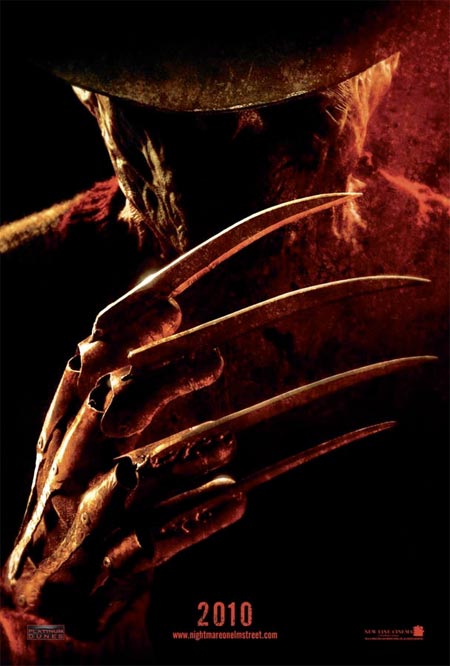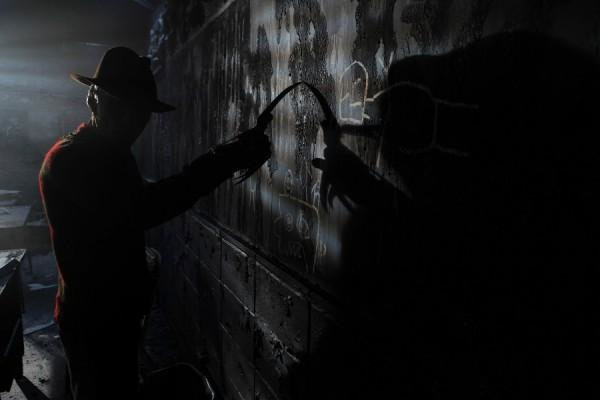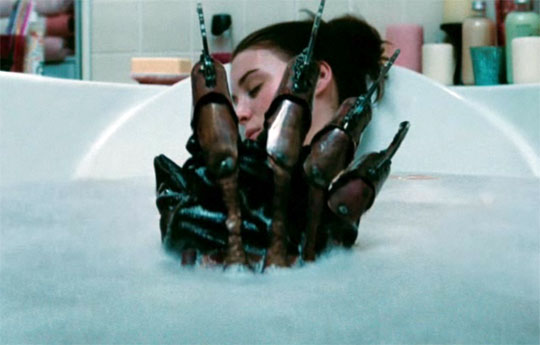Tue 4 May 2010
The Nightmare Continues
Posted by Ethan under Film Review, NYC Film Critic
1 Comment
A Nightmare on Elm Street
Directed by Samuel Bayer
Starring Jackie Earle Haley, Rooney Mara, Kyle Gallner, Thomas Dekker
*1/2
There are those horror filmmakers who have a genuine respect for the genre and always strive to craft distinctive movies that entertain and terrify, even if the finished product doesn’t always measure up to their ambitions.
And then there are the folks the run Platinum Dunes, a production company founded in 2001 by Michael Bay, Brad Fuller and Andrew Form that devotes itself primarily to churning out slick-looking, but entirely generic remakes of dormant horror franchises. By now, it’s clear that the company’s standard operating procedure is as so:
1) Acquire the remake rights to a name-brand franchise that was popular twenty years ago.
2) Cast a group of interchangeable actors in their late ’20s and force them to play high-schoolers.
3) Hire a music-video director whose creative choices can easily be ignored in the editing room.
4) Produce a 90-minute movie that’s little more than a series of gory deaths linked by the barest semblance of a plot.
5) Release the movie in the winter or early spring and trust that name recognition alone will lure audiences in.
I wish I could say that moviegoers have seen through Platinum Dunes’ cynical ploy for their money by now, but this M.O. has worked almost every single time. Of the four remakes–a group that includes The Texas Chainsaw Massacre, The Amityville Horror, The Hitcher and Friday the 13th–Platinum Dunes released prior to their latest effort, A Nightmare on Elm Street, only one failed to top the box office its first weekend out. (For the record, the lone underperformer was The Hitcher.) Now, this new Nightmare has continued their winning streak, bowing to $32 million and displacing the leggy animated hit How to Train Your Dragon from the number one spot. With numbers like that, who cares that it’s a waste of celluloid?
Well I do for a start and not because I consider the original Nightmare an unassailable masterpiece. Truth be told, I went into the remake barely remembering a thing about Wes Craven’s 1984 hit. (I should also mention that I’ve never seen any of the sequels that littered multiplexes during the ’80s and ’90s.) It was only after leaving the theater that I went back and re-watched Craven’s film and was startled by how blatantly Samuel Bayer–the credited director here–stole from his predecessor. Forget the term remake, A Nightmare on Elm Street should be described as a photocopy. Virtually every major set-piece that appears here is lifted directly from the original, complete with the same blocking and camera placement. At least when Gus Van Sant did this with Psycho, he let everyone know that he was deliberately replicating Hitchcock’s film frame-for-fame. The makers of A Nightmare on Elm Street 2.0 are trying to pass off obvious theft as new material.
The only change the movie does make to established Nightmare lore has to do with the background and motives of the franchise’s iconic boogeyman, Freddy Krueger (played here by Jackie Earle Haley, taking over the role from its originator Robert Englund). The first time around, Freddy was a suspected child murderer executed vigilante-style by the otherwise upstanding parents that populate the sleepy suburban thoroughfare Elm Street and subsequently returned from beyond the grave to haunt and kill the offspring of his murderers in their dreams. In this version, he’s a pedophile and the four children he molests grow up to be the teenagers he terrorizes when they go to sleep. The filmmakers must have thought that this change would make Freddy scarier, but all it really accomplishes is adding a queasy unpleasantness to the proceedings, particularly in the scenes where he taunts the now-grown girl who was his favorite plaything. Thanks to Freddy’s new origin, these moments play like preludes to rape as well as murder.
As Krueger, Haley does what’s required of him–which mainly consists of growling and grimacing beneath layers of make up–but there’s nothing at all memorable about his performance. The same goes for the actors cast as the film’s ostensible heroes, none of whom demonstrate a single iota of personality. One almost longs for the easily identifiable stereotypes that populate cheesy ’80s horror movies–you know, the slut, the jock, the nerd and the shy virgin. This Nightmare doesn’t even offer that basic level of characterization; Freddy may just as well be killing the same person over and over again. Repetition without innovation–that’s the mission statement of the new Nightmare on Elm Street and Platinum Dunes itself in a nutshell.
A Nightmare on Elm Street is in theaters now.




Haven’t seen it, but this sounds completely accurate